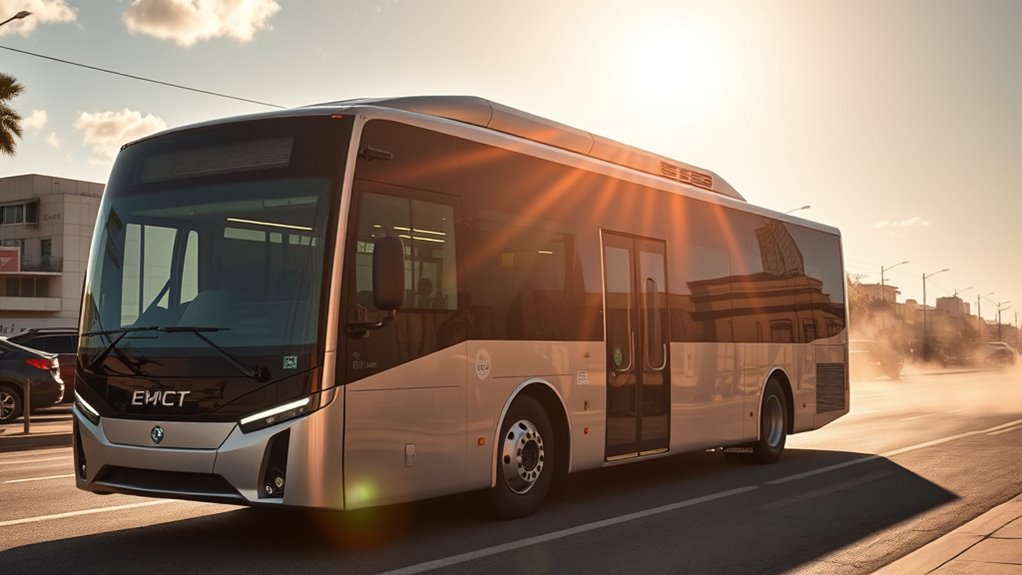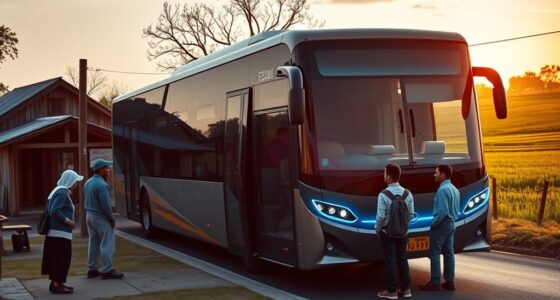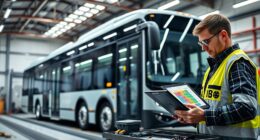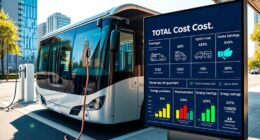In hot climates, keeping your electric bus cool and comfortable involves more than just air conditioning. Solar panels on the roof can generate clean energy during peak sunlight to power cooling systems and reduce energy drain. Adding interior ventilation helps circulate air effectively, while insulation minimizes heat transfer into the bus. Combining these strategies creates a more energy-efficient and comfortable environment, ensuring reliable operation. Learn how integrated solutions can help your electric bus perform better in hot weather.
Key Takeaways
- Solar panels on bus roofs generate renewable energy to power cooling systems, reducing reliance on main batteries.
- Integrating interior ventilation systems improves air circulation, decreasing the load on air conditioning units.
- Proper insulation minimizes heat transfer into the bus, maintaining cooler interior temperatures naturally.
- Combining solar energy with advanced ventilation offers a sustainable, energy-efficient solution for hot climates.
- Strategic component placement maximizes sunlight exposure and cooling efficiency, enhancing passenger comfort.

Electric buses face significant cooling challenges that can impact their performance and reliability. When operating in hot climates, maintaining a comfortable interior temperature becomes more than just a matter of passenger comfort; it’s essential for safety, efficiency, and the longevity of the vehicle’s components. One effective approach involves integrating solar panel technology to power cooling systems, reducing reliance on traditional electrical sources and helping to offset the energy drain caused by air conditioning units. Solar panels installed on the bus roof can generate clean energy during peak sunlight hours, providing a sustainable way to support interior cooling without depleting the bus’s main battery. This integration not only enhances energy efficiency but also extends the operating range, critical in hot regions where frequent recharging may be inconvenient or impractical. Additionally, implementing cybersecurity measures to protect the bus’s control systems ensures the safety and reliability of these integrated technologies.
Integrating solar panels on electric buses boosts cooling efficiency and extends range in hot climates.
Alongside solar panel integration, interior ventilation systems play a vital role in combating heat buildup inside the bus. Modern ventilation solutions are designed to circulate air more effectively, helping to remove hot, stagnant air and bring in cooler, fresh air from outside. These systems can be automated to adjust airflow based on interior temperature sensors, guaranteeing crucial cooling without excessive energy consumption. Proper ventilation reduces the strain on air conditioning units, which are often power-intensive in electric buses, thereby preserving battery life and maintaining consistent climate control. When these systems work in tandem with solar-powered cooling options, you create a more resilient and energy-conscious environment for both passengers and drivers.
You also need to contemplate the placement and insulation of these components. Proper insulation minimizes heat transfer, keeping the interior cooler and reducing the workload of ventilation and cooling systems. Additionally, strategic placement of solar panels can maximize sunlight exposure, especially in regions where the sun’s position varies throughout the day. This not only ensures a steady supply of renewable energy but also helps keep the bus’s interior temperature in check during the hottest parts of the day. Combining solar panel integration with advanced interior ventilation systems offers a comprehensive strategy for tackling heat-related issues.
Ultimately, managing heat in electric buses during hot weather requires a multi-faceted approach. By leveraging solar energy and improving ventilation, you can enhance comfort, reduce energy consumption, and extend the vehicle’s operational lifespan. This integrated effort ensures your electric fleet remains reliable and efficient, even under the most challenging climate conditions. Staying ahead of cooling challenges means better service and happier passengers, making hot climate adaptation a smart investment for any electric bus operator.
Frequently Asked Questions
How Do Electric Buses Perform in Extreme Heat Conditions?
In extreme heat, electric buses perform better when equipped with proper thermal insulation and exterior shading. You’ll notice they stay cooler and more comfortable, as insulation reduces heat transfer, and shading blocks direct sunlight. These features help maintain ideal battery and passenger temperatures, ensuring your bus runs efficiently and safely. By implementing these strategies, you can confidently operate electric buses even in the hottest climates, minimizing heat-related issues.
What Cooling Technologies Are Most Energy-Efficient for Electric Buses?
Think of your electric bus as a ship sailing smoothly through a scorching sea. To keep it cool, you’d want energy-efficient tools like solar shading and thermal insulation—like a sail that blocks the sun and a sturdy hull that retains coolness. These technologies minimize energy use while maintaining comfort. Solar shading reflects sunlight, and thermal insulation keeps interior temperatures stable, making your bus a cool, efficient vessel in hot climates.
How Does Heat Impact Battery Life and Performance?
Heat accelerates battery degradation, reducing your electric bus’s performance and lifespan. High temperatures cause thermal management systems to work harder, which can drain energy and strain the battery. When you don’t control heat effectively, you risk diminished range and costly replacements. Proper thermal management helps keep the battery cool, ensuring it maintains ideal performance and longevity, especially in hot climates. Staying vigilant about temperature impacts protects your investment and keeps your bus running smoothly.
Are There Specific Design Features to Enhance Passenger Comfort?
Imagine stepping into a cool oasis on a scorching day. You’ll find that design features like superior seating ergonomics cradle you comfortably, while tinted windows block harsh sunlight, creating a shaded haven. These thoughtful touches make your ride smoother and more pleasant, helping you relax despite the heat. By focusing on passenger comfort with ergonomic seats and effective window tinting, electric buses transform into cool retreats amid the blazing sun.
What Maintenance Challenges Are Unique to Cooling Electric Buses?
You’ll face unique maintenance challenges with cooling electric buses, especially around thermal insulation and ventilation systems. Over time, thermal insulation can degrade, reducing cooling efficiency and increasing energy use. Ventilation systems require regular inspections and filter replacements to prevent dust buildup and guarantee proper airflow. Neglecting these components can lead to overheating, passenger discomfort, and increased operational costs, so proactive maintenance is essential to keep your electric bus climate-controlled and running smoothly.
Conclusion
As you navigate the bustling streets under a blazing sun, imagine the electric bus you’re on, its cool interior offering relief from the heat. Behind the scenes, engineers battle to keep the cabin comfortable, like guardians shielding passengers from the scorching rays. With innovative cooling systems and smart technology, they work tirelessly to turn sweltering rides into rejuvenating journeys. So, next time you hop aboard, remember the quiet effort keeping you cool amidst the summer’s fiery embrace.









